The RuneQuest Starter Set has already been reviewed many, many times, but since I have already gifted it three times this holiday season (yes, to my unsuspecting players), its merits and faults have been on my mind… and what kind of a Glorantha focused website would we be if we didn’t have some reviews? We’re just slow about writing them, being, like, two products behind schedule. But we are the God Learners, and you wouldn’t believe the kind of administrative puzzle we have to go through for approval of that kind of thing.
The Box
As I wrote earlier this year on my personal blog, the RuneQuest Starter Set is part of the “RPG boxed set come back”, where the boxes of yore are coming back as introductory game material.

Here, the RuneQuest Starter Set is following in the footsteps of its older Call of Cthulhu Starter Set sibling, with a very sturdy box of unusual size. The reason for this unusual size is that all the booklets and handouts inside the box don’t leave any empty space (unlike some other disappointingly empty Starter Sets we won’t name here), so the set of dice that Chaosium provides has to find room at the top, with a taller-than-usual box.
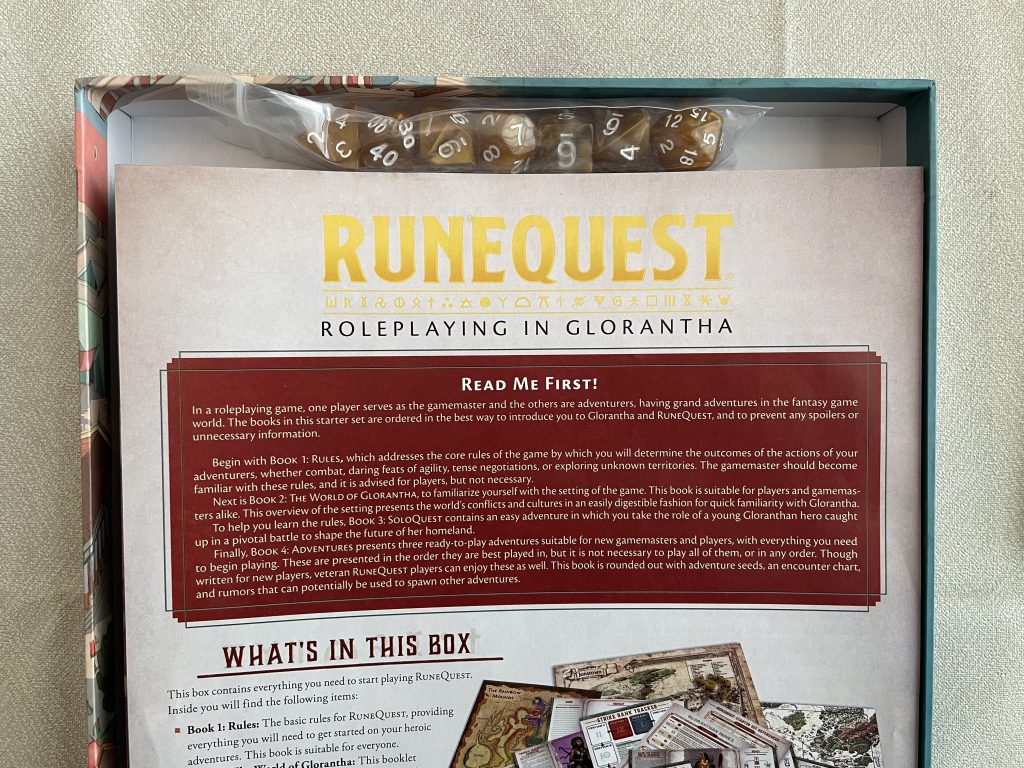
If you have very snug shelves, you might have trouble fitting the RuneQuest Starter Set on them. However, if you have the Call of Cthulhu Starter Set, some old Chaosium boxed sets like Thieves’ World or Superworld, other tall game boxes like Harnmaster, or any kind of European game books or boxes, then the RuneQuest Starter Set should fit perfectly next to them.
Since we are looking at the dice, those are pretty nice by the way: they are very legible, and have a nice colour that evokes the bronze age setting of Glorantha.
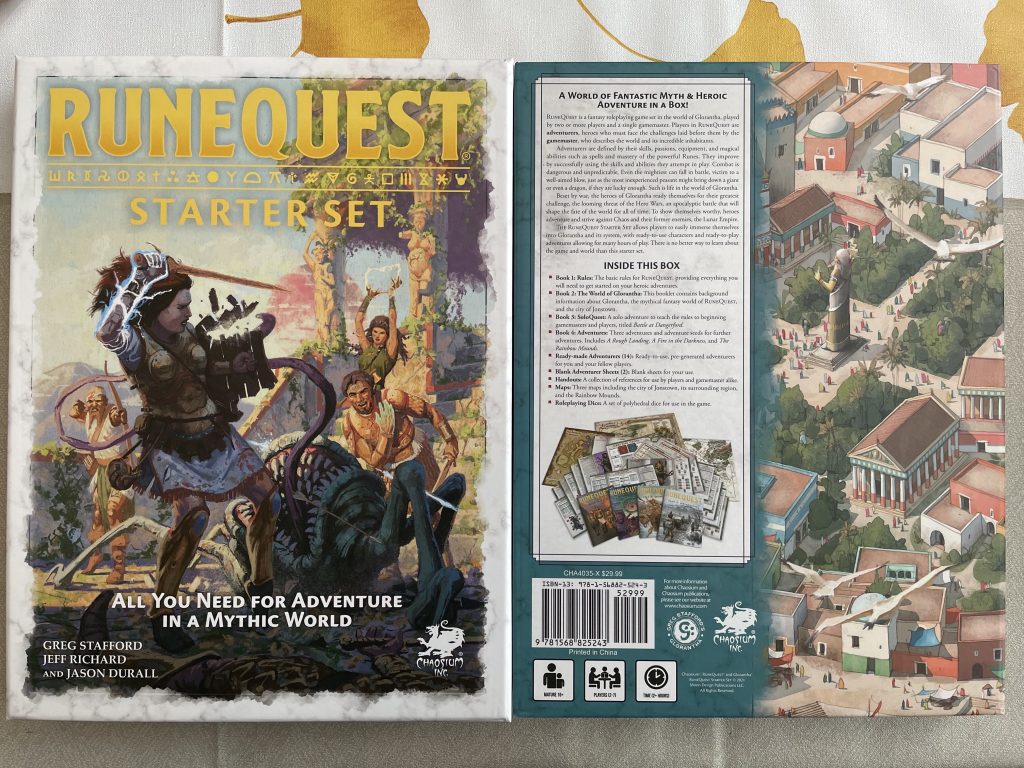
The box itself is quite impressive. It’s among the sturdiest boxes of all the starter sets I have in my library, and the art is stunning, original, and evocative. Vasana’s pose is even reminiscent of the original female warrior on the first two editions of RuneQuest, which is a nice touch for the fans. The only nitpicky remark I have here is the back illustration (right, above) which depicts what seems to be a port city, maybe Nochet. It does a great job of showing the colour and density of a bronze age city, but it’s not representative of the region described in the booklets where players will have their first adventures.
Another notable aspect of the RuneQuest Starter Set is its weight… so much so that my first step was to weigh it against my other starter sets!
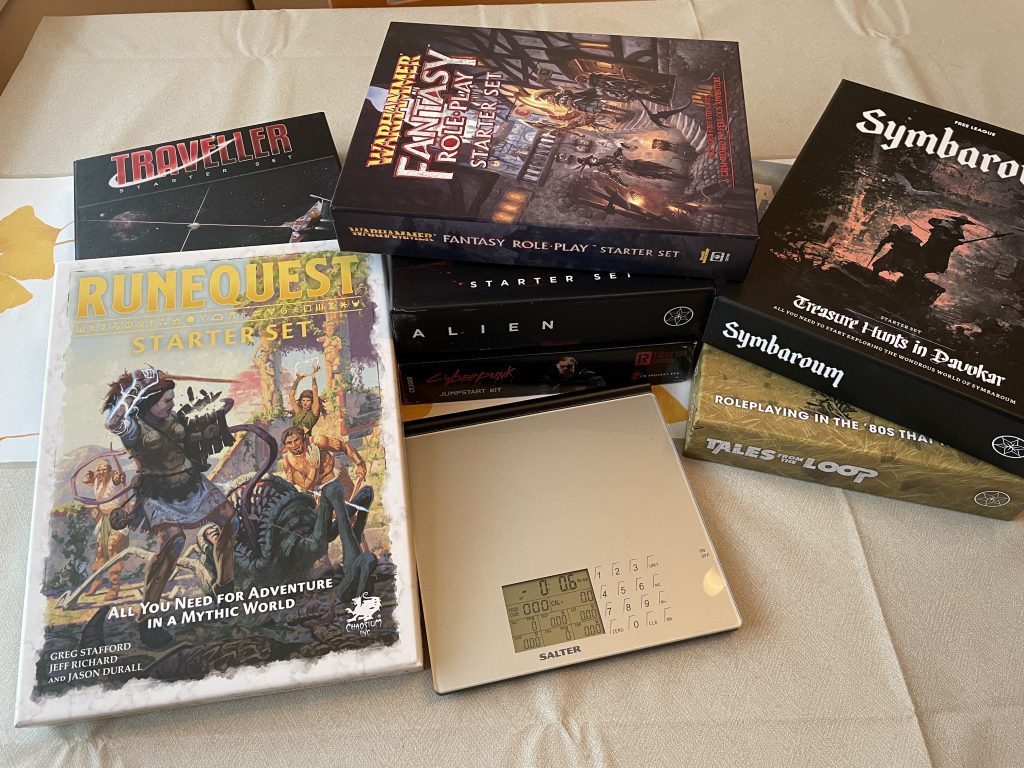
The RuneQuest Starter Set comes in at a whooping 1.380 kgs! The lightest of the bunch is around 670 grams, with most of the others between 800 grams and 1 kg. The excellent Alien RPG Starter Set is right behind RuneQuest, at 1.300 kgs (I hope I didn’t forget to put everything back in it to get a proper measurement!), and the even more excellent Warhammer Fantasy Roleplay Starter Set (which we will mention again) is just above one kilogram.
You might be shocked to learn however that RuneQuest’s box is not the heaviest of the bunch. There is another one on this picture that comes in at a stunning 1.700 kgs! It’s the Mongoose 2nd edition Traveller Starter Set, whose box is also notable for having a nice little ribbon at the bottom to help you lift the contents easily (publishers, take note). But as far as I can tell, it’s not available anymore, except in PDF on DriveThruRPG, so I guess it doesn’t count? Yeah, let’s go with that. The RuneQuest Starter Set is the heaviest on the market! Yay!
Introduction and Reference Sheets
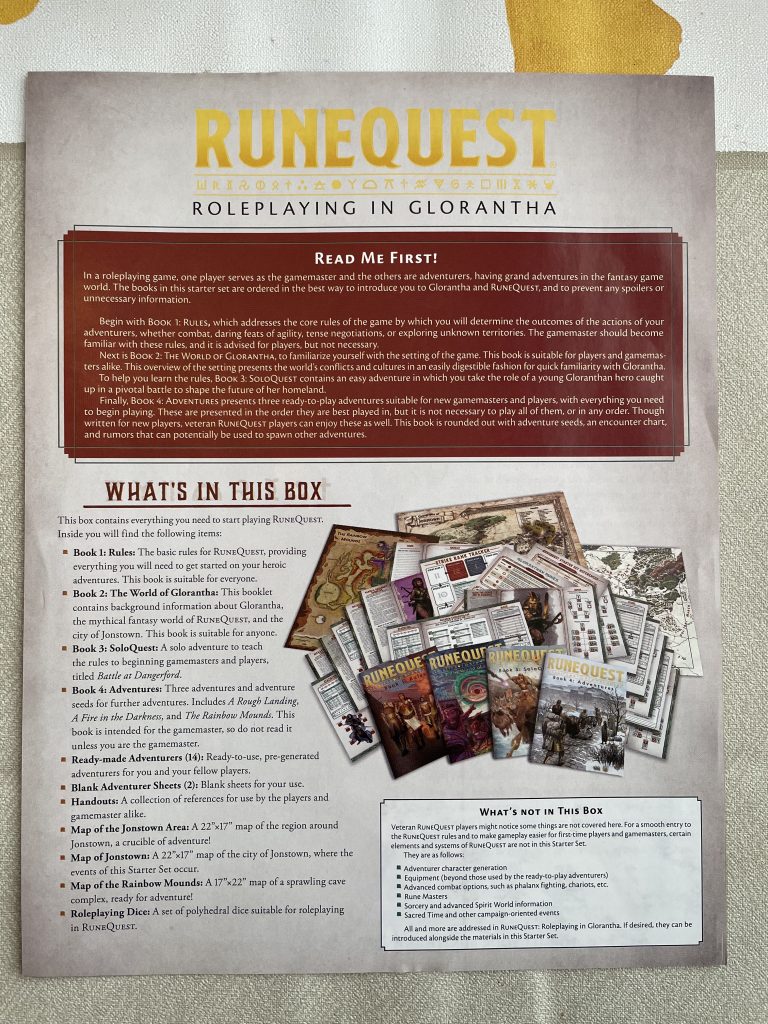
When you open the RuneQuest Starter Set box, you’re greeted with a traditional “what’s in the box” sheet. I love that Chaosium also thought of including a “what’s NOT in the box” section, to set people’s expectations right. In particular, the box does not contain character creation rules: there just wasn’t enough room, especially with the lengthy Family History section that takes up almost 20 pages in the core rulebook. Instead, Chaosium provides more than a dozen pre-generated adventurers, which is more than enough for getting started. Other notable omissions are rules for high level characters like Shamans and Rune Masters, which is again understandable for a starter set.
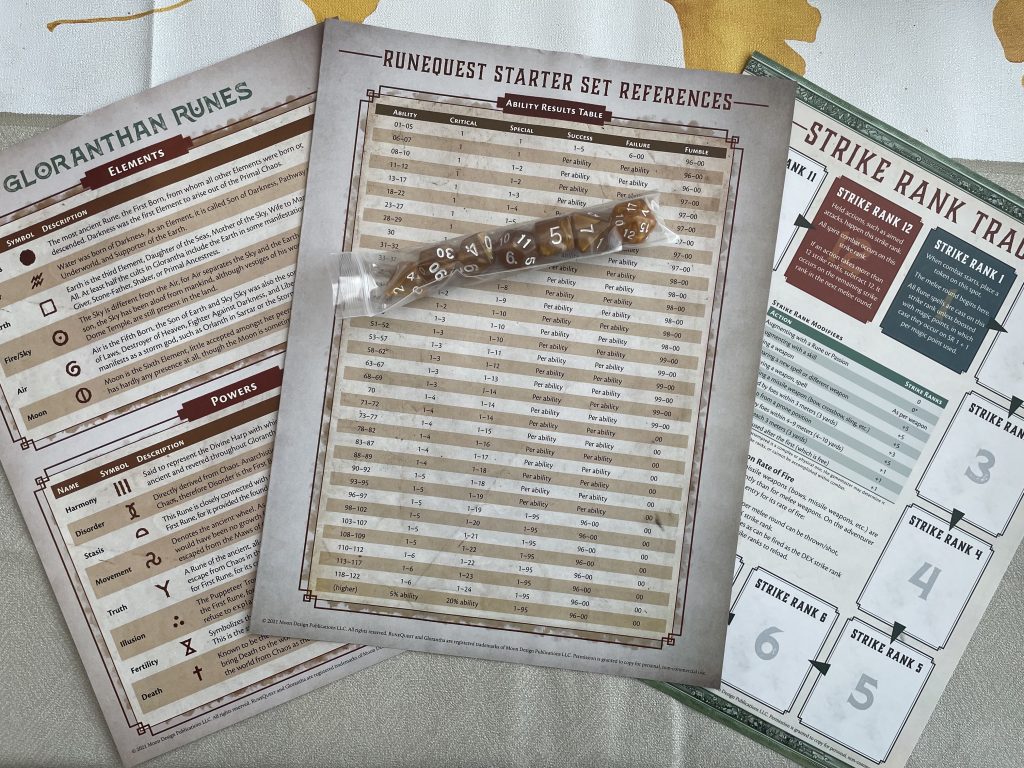
A few reference sheets are provided: the usual Gamemaster aids (ability results table, resistance table, hit locations, and so on), a player-facing description of Gloranthan Runes, and a Strike Rank Tracker for combat (which also nicely incorporates some rules summary).
The Strike Rank Tracker is made of thick paper, which is excellent since it’s bound to be used a lot during gameplay. Sadly the other two handouts are made of “normal” paper, which is surprising because I would actually expect them to be manipulated a lot more: the Strike Rank Tracker would probably just sit there on the table, while the other two are flipped, picked up, and passed around all the time even outside of combat.
Last, the back of the Strike Rank Tracker is an ad for other Chaosium products. It would have been nice to see, say, the ability result table on the back instead, so that you can flip this reference sheet on one side during combat, and on the other side for other scenes.
Booklets
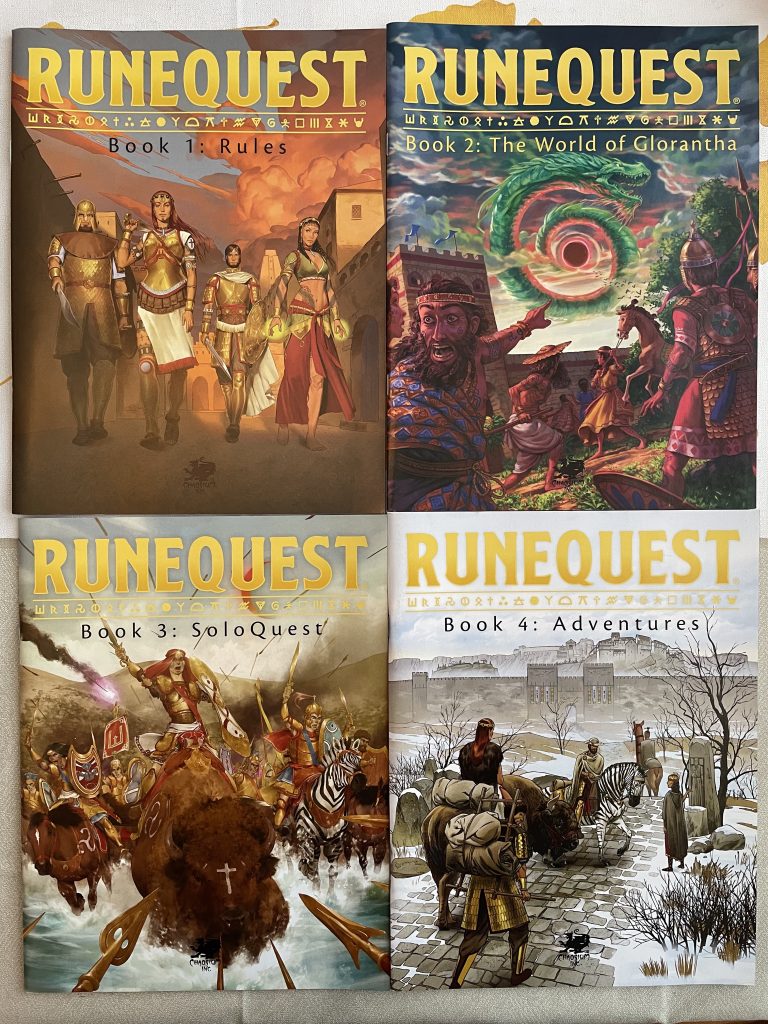
The RuneQuest Starter Set’s main material is split between four books. The first book is the rulebook, the second describes the world of Glorantha in general and the area around Jonstown in particular, then there’s a “SoloQuest” book, and a book of adventures.
The SoloQuest is notable because it’s both a call back to RuneQuest’s early tradition of “Choose You Own Adventure“-style books (which are now available in Print-on-Demand), and to Call of Cthulhu’s own solo adventure in its Starter Set.
If you turn the booklets around, you realize that they all line up and form a map of northern Sartar, which is a nice touch. You know I’m a sucker for maps.
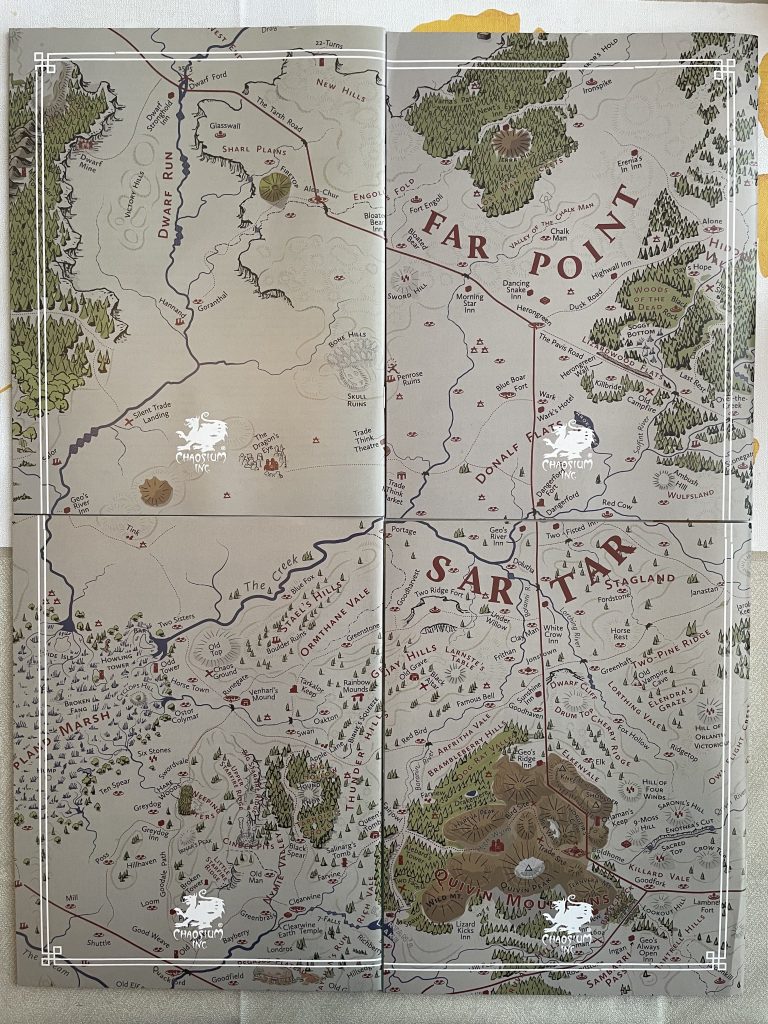
Book 1: Rules
The first book throws you into the complex and crunchy rules of RuneQuest. I’m not totally convinced that this is the best way to make a good impression on new players, but Chaosium put some effort in simplifying the rules and making them easily understandable.
But first things first. The first few pages deal with the usual introductory material: what’s a roleplaying-game, how do you roll dice, and so on. More importantly, it has some good summary of RuneQuest’s core activity: playing adventurers that are members of a community and a cult, and who will rise up as heroes during the Hero Wars.
The next few chapters of the rules booklet by and large contains similar material as the core rulebook, although the text has been shortened in many places. In some cases, this is actually beneficial for long-time RuneQuest players and gamemasters: the core rulebook has, in my opinion, many editing problems, so the shorter and simpler rules of the starter set help understand the “rules as intended”. In many other cases, however, the same editing problems persist and new players are bound to have the same slew of questions as everybody else. Let’s point these people to the Well of Daliath!
In some occurrences, rules have been modified to be simpler. The most obvious example is that the core rulebook’s fumble table, which is rolled on with a D100, has a simpler D20-based version in the starter set. This is fine, and quite welcome for a starter set product.
What’s more baffling are rules modifications that don’t really simplify anything: they’re just… different from the core rulebook for no reason I can think of. For instance the attack/parry table has a couple of subtle differences between the two rulesets. Sometimes, the starter set even introduces entirely new rules, which seems counter-intuitive for a product that aims to simplify things. For instance, there are some new rules around language which cap your adventurer’s communication skills… I don’t like these rules, and will thoroughly ignore them. I’m just surprised to see new rules in a starter set: I expected less of them.
Thankfully, this problem is quite limited.
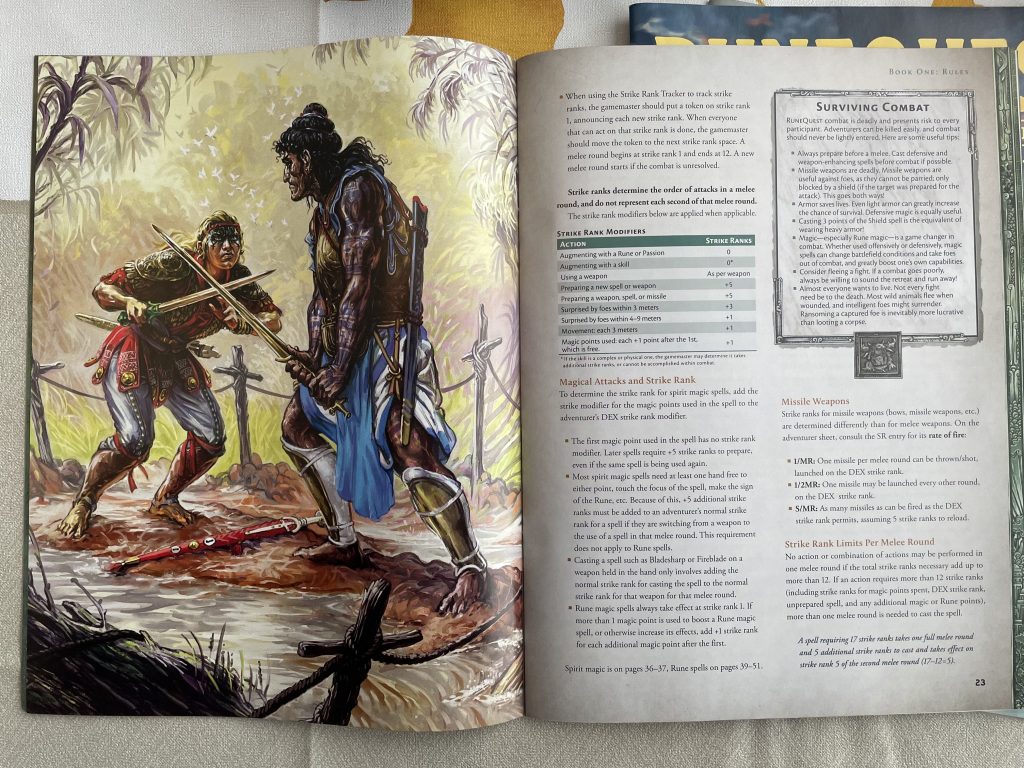
These early rules chapters (game system, skills, combat) are occasionally decorated with very nice art pieces plundered from Chaosium’s older books, such as this wonderful duel scene (above) from the mind-blowing Guide to Glorantha.
Once we get into the Magic chapter, things become quite shortened compared to the core rulebook. Only spells and rules needed by the adventurers are described, and everything else gets a hint or short write-up, nudging you to get the core rulebook if you want to know more. The material on the Spirit World and Shamanism is short, since neither the adventures of Book 4 nor the pre-generated adventurers would have much to do with it, but there’s enough to whet a new player’s appetite. I really appreciate that because these are some of the game elements that set RuneQuest and Glorantha apart for me.
Book 2: The World of Glorantha
The second booklet in the box describes Glorantha in general, and the city of Jonstown (and surroundings) in particular, which acts as the stomping grounds for new players.
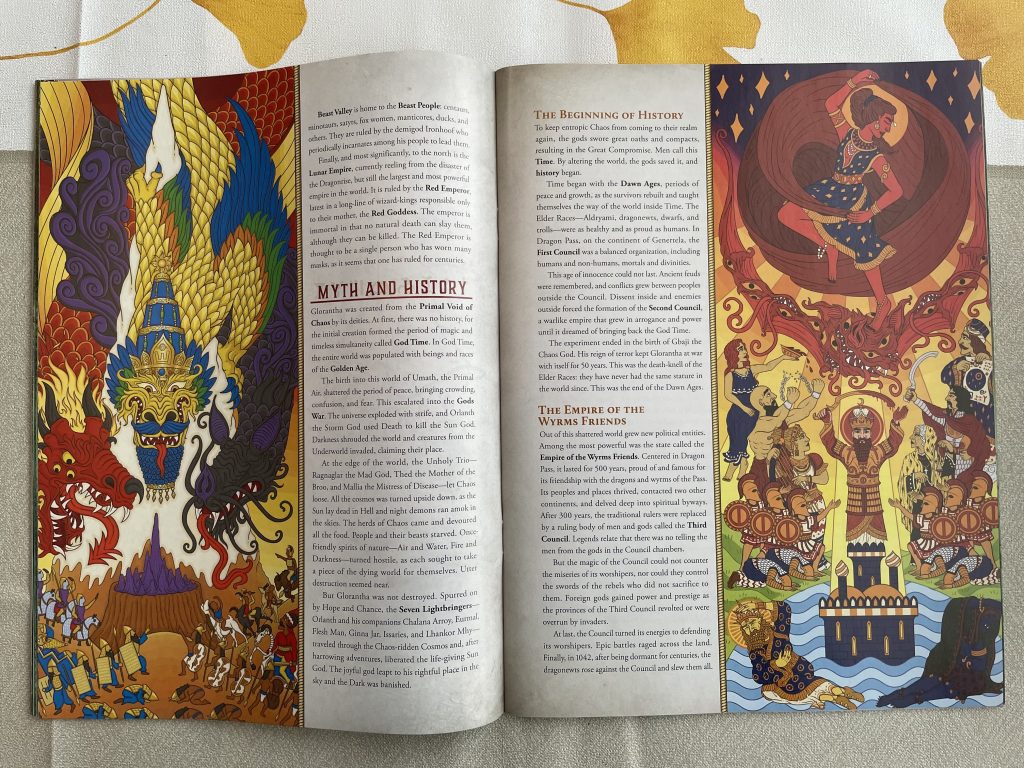
In the first part, Chaosium really sharpened their ability to distill Glorantha’s essence in a minimum of pages, with some nice art (including new stuff, as far as I can tell, see above). In a short 20-ish pages, we learn about the bronze age flair of the setting, the magic, the Gods, the Runes, and other explicitly called out “Unique Aspects of Glorantha”. We learn about Dragon Pass, its myths, and its history from the Gods War all the way to the present. This is the best summary of Glorantha I’ve seen to date: short enough to keep the reader’s attention, but with enough detail to keep it exciting and unique.
The second part of the booklet details the city of Jonstown and its surroundings. This is where the RuneQuest Starter Set shines: Chaosium wanted to release a product that would appeal to new and experienced players alike by providing valuable exclusive material, and this is our first encounter with it.
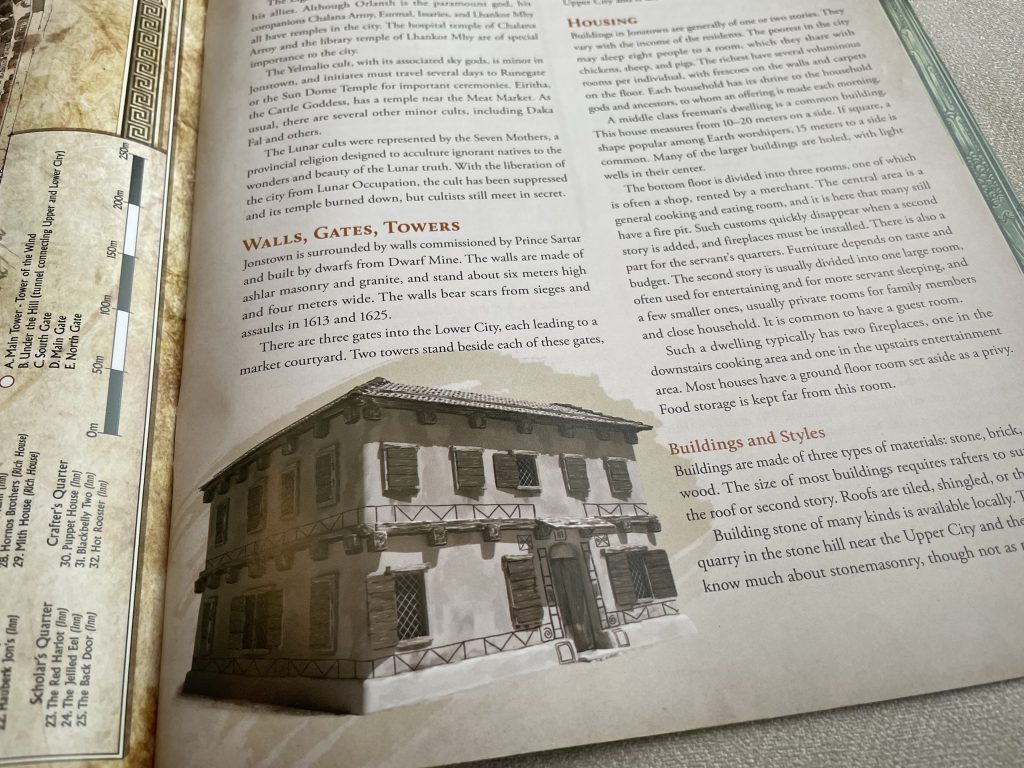
Not only is this an in-depth look at a Sartarite city that hasn’t been featured much in official books (I think the only existing write-up of Jonstown is in the now defunct HeroQuest line), it’s also a great reference for any Sartarite city, period. The information on buildings, citizenship, walls and guards, markets and trade, government, militia, and more is already worth half the price of the box in my opinion. This kind of “everyday life” information was what I was lacking when I originally read the core rulebook (being wholly ignorant about the bronze age at the time), which meant I had trouble picturing the world of Glorantha in practice.
Next are write-ups for important NPCs, with some good background and detailed stat blocks for each. The remaining 20 or so pages weren’t as exciting to me, however, because they were a mostly descriptive list of places across the city. The gamemaster will have to come up with their own ideas to fill the city with intrigue, adventure, secrets, and more, using this rather cold and factual material as the foundation… by comparison, the previously mentioned Warhammer Fantasy Roleplay Starter Set fills its description of Ubersreik with places and NPCs both big and small, and there’s an adventure hook (or two!) on every page:
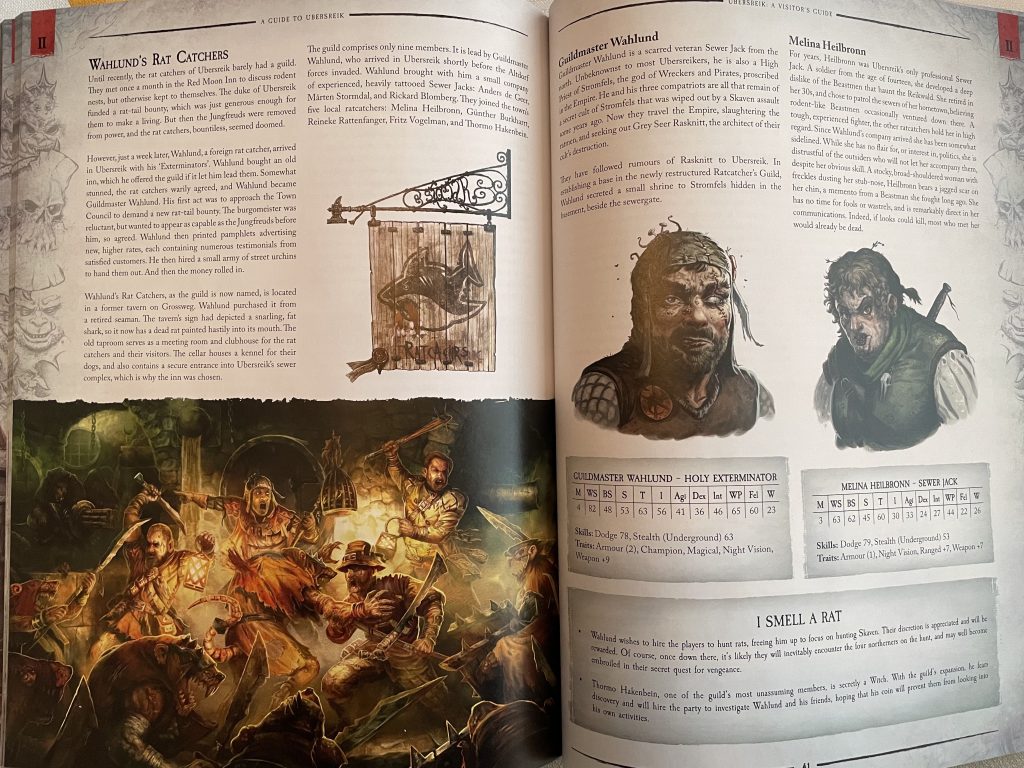
Thankfully, Book 4: Adventures contains a few scenario seeds and encounters, which mitigates this problem a bit.
Going back to Jonstown, the one thing I got very excited about is the map. It’s an absolutely stunning map, both pretty and functional, extremely readable, and equipped with a scale! (believe me, it’s not a given with Gloranthan maps…)
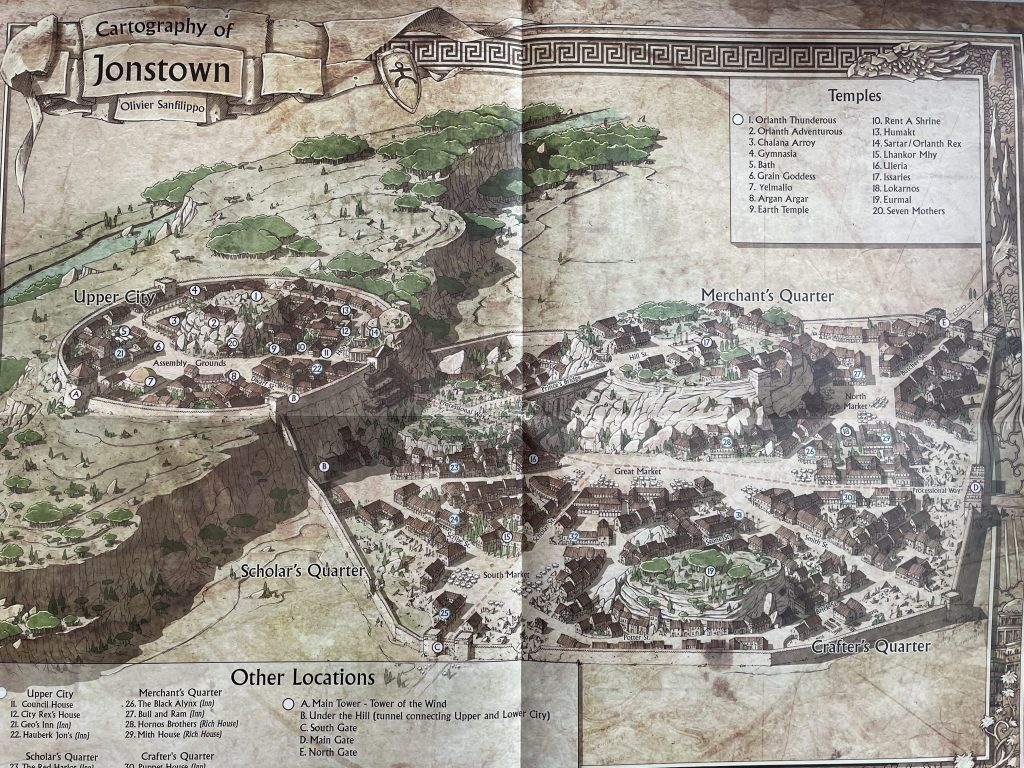
The map pictured above is actually a poster-sized handout available in the box (there’s a smaller full-page version in Book 2), but you get the idea: it’s very good looking! And while we are on maps, let’s look at the other poster map, which covers northern Sartar:

This is another great map: it’s both prettier and vastly more legible than the maps from the core rulebook. Somehow, it looks to me, style-wise, like a modernized version of classic Gloranthan maps such as the Dagori Inkarth map from Trollpak.
Book 3: SoloQuest
Next, we have the SoloQuest book, which puts the reader in Vasana’s… err… greaves during the epic Battle of Dangerford. This is a great choice to put a new player in the heart of Gloranthan and RuneQuest action, and you can even play this adventure for free in your browser.
The adventure does a good job to show many different mechanics, introduce recent events of Dragon Pass, and get up-close with important NPCs. After running the adventure, you not only should have a better grasp on the crunchy RuneQuest rules (there’s often a big difference between “getting it in theory” and “getting it in practice”!), but you also should get an idea of the grittiness and “swinginess” of RuneQuest combat: anything could happen, and playing through a few scenes twice yields vastly different results, from glorious to deadly.
Sadly, the solo adventure also exposed one of the classic problems with RuneQuest combat. Without spoiling much, at some point you get a chance to fight a duel against a Lunar soldier. Up until then, I was playing the adventure along with my 10 year old kid who was quite invested in the story. But with Vasana’s 90% Broadsword up against an opponent’s 80% Kopis, the game came to a crawl, as we rolled and rolled and rolled, neither combatant able to hurt the other. My kid got bored and moved on to something else, asking me to call him back “when something happens”. Ouch. “Out of the mouths of babes” and all that, I guess, eh?
Generally speaking, this SoloQuest was a solid and enjoyable experience. I preferred the solo adventure from the Call of Cthulhu Starter Set, however. Maybe it’s because I’m such a giant horror gaming fan, but maybe it’s because it’s so innovative. It is actually the first booklet in the Call of Cthulhu Starter Set box: it makes you go through a simple version of character creation as part of the first few steps in the story, and follows by teaching you the rules in an interactive way. This makes getting into Call of Cthulhu so easy and entertaining! In comparison, the RuneQuest Starter Set has a more “standard” setup, where you first learn about the rules, then the setting, and then you play a game to see if you got it all correctly. The innovation of having this first game be a solo adventure remains, however, so the RuneQuest Starter Set keeps a leg up on the non-Chaosium competition. I don’t know if Chaosium could have done it differently anyway, since RuneQuest and Glorantha are much more complex to grasp than Call of Cthulhu and, well, Earth… I would love to read a “Designer Diary” about whether they tried it!
Book 4: Adventures
I’m obviously not going to say much about the last booklet in the box, since it contains the adventures and I’m trying to keep this review spoiler-free. What I can say is that it contains three adventures, and a few adventure seeds and rumours for further gaming.
The first adventure has a pretty simple premise that will work wonders for players migrating from other fantasy games like D&D or Pathfinder. You can see an actual play of it here, courtesy of the Glass Cannon. But I think it lacks in Gloranthan flavour, and for a “first contact” I much prefer the Quickstart adventure “The Broken Tower”, which is free to download in PDF.
The second adventure is great because it has the kind of stuff I like, such as a big investigation element. Both the first and second adventures are also well anchored into recent events of the setting, which is great.
The last adventure is an update of The Rainbow Mounds, originally from the Apple Lane supplement (now available in Print-on-Demand), where the players are sent to the titular caves. This is a classic Gloranthan dungeon crawl, where the dungeon has a fine backstory, its inhabitants have agendas and reasons to live there, and things are more complicated than they seem.
Pre-Generated Characters
The last material in the RuneQuest Starter Set is a pile of 14 (fourteen!) pre-generated characters. Surely there will be enough choice to mitigate the lack of character creation rules: these pre-gens range from a blood-thirsty axe-wielding Babeester Gori, to a pacifist Chalana Arroy healer, to a “reformed” Lunar soldier, and more. The heroine of the SoloQuest book, Vasana, is of course there too.
These pre-gens come in fancy “folio” format, as previously seen in the Warhammer Fantasy Roleplay Starter Set (which also forgoes character creation rules, by the way), and you can see the resemblance:
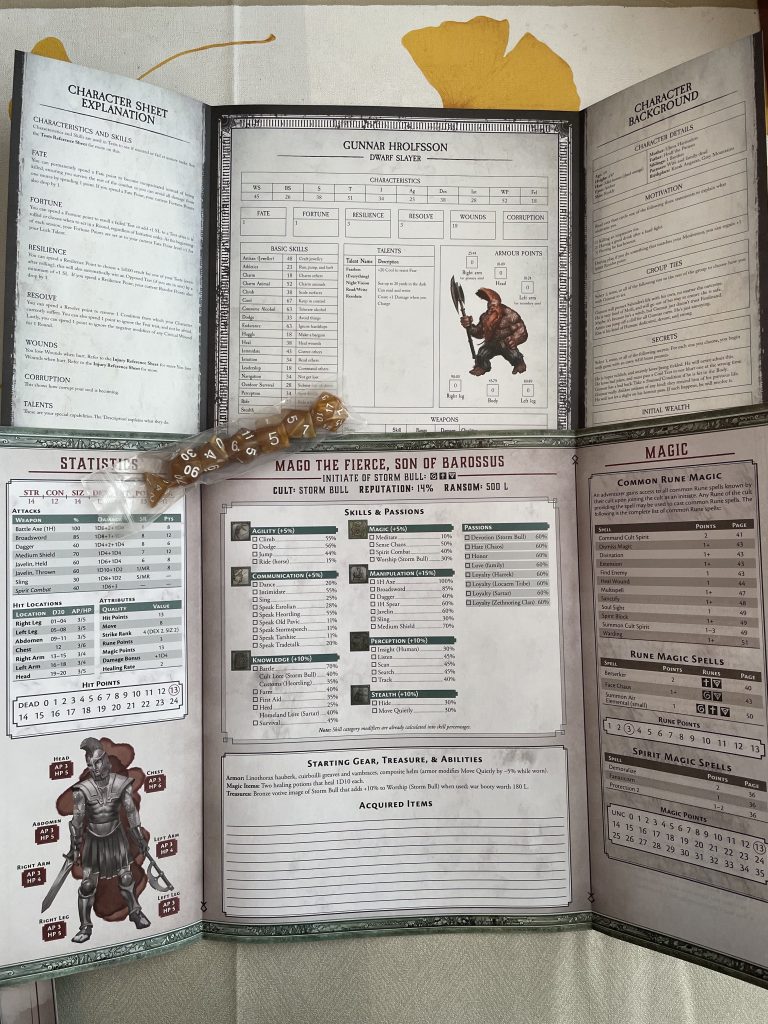
WFRP’s folios are printed on thick paper, so the RuneQuest ones feel flimsy in comparison. On the other hand, WFRP only offers six pre-gens, so there must have been a compromise there.

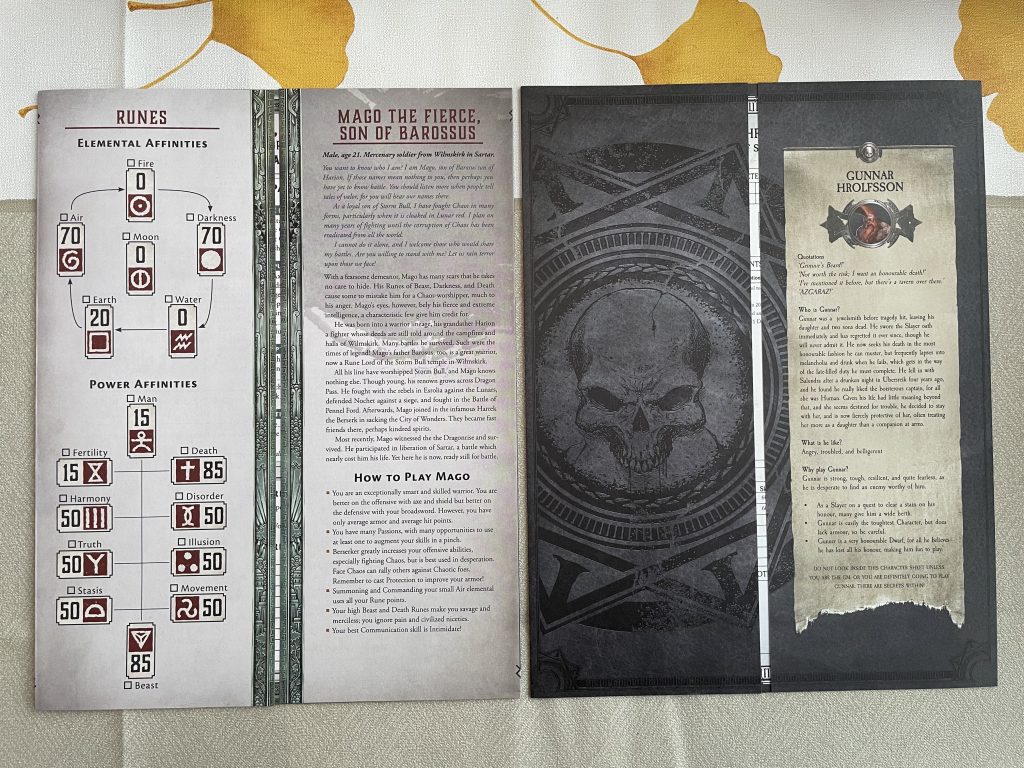
Another small problem is with what goes where. WFRP puts all the character’s abilities in the folio’s interior: the side panels’ exterior only has character background (above, right). RuneQuest’s folios have the character’s Runes on the left panel’s exterior (above, left), which means you have to flip it open and closed depending on what ability score you need… it’s easy, at least at first, to look for a Rune rating for a while before remembering that it’s on the other side.
Conclusion
Overall, the RuneQuest Starter Set is a fantastic product, especially given the very low price tag of about $30 USD. In my opinion, it sits firmly in the now triumvirate of the best RPG Starter Sets on the market today: Call of Cthulhu, Warhammer Fantasy Roleplay, and RuneQuest. With two of them from Chaosium, and all three based on class-less D100 systems, one might say I’m biased… but I’m ready to argue my points if needed! Well… who am I kidding… I’m a software engineer and I’m French: of course I’m ready to argue anything.
One of Chaosium’s goals was to make this product useful even for veterans of RuneQuest and Glorantha, and I think they have greatly succeeded here. Out of a total of 272 pages across all four booklets, there’s about 185 pages of new material, from the Jonstown write-up to the SoloQuest and adventures: that’s more that two-thirds of useful stuff for someone who already owns the core rulebook! The poster map of Sartar, the pre-gens, and the Strike Rank Tracker are just icing on the cake at this point!

My final advice is that the best “introduction to Glorantha” combo is to offer one gift for your RPG nerd friend, and one gift for their family: the RuneQuest Starter Set plus Khan of Khans is your best bet at a successful summoning spell for your gaming table!


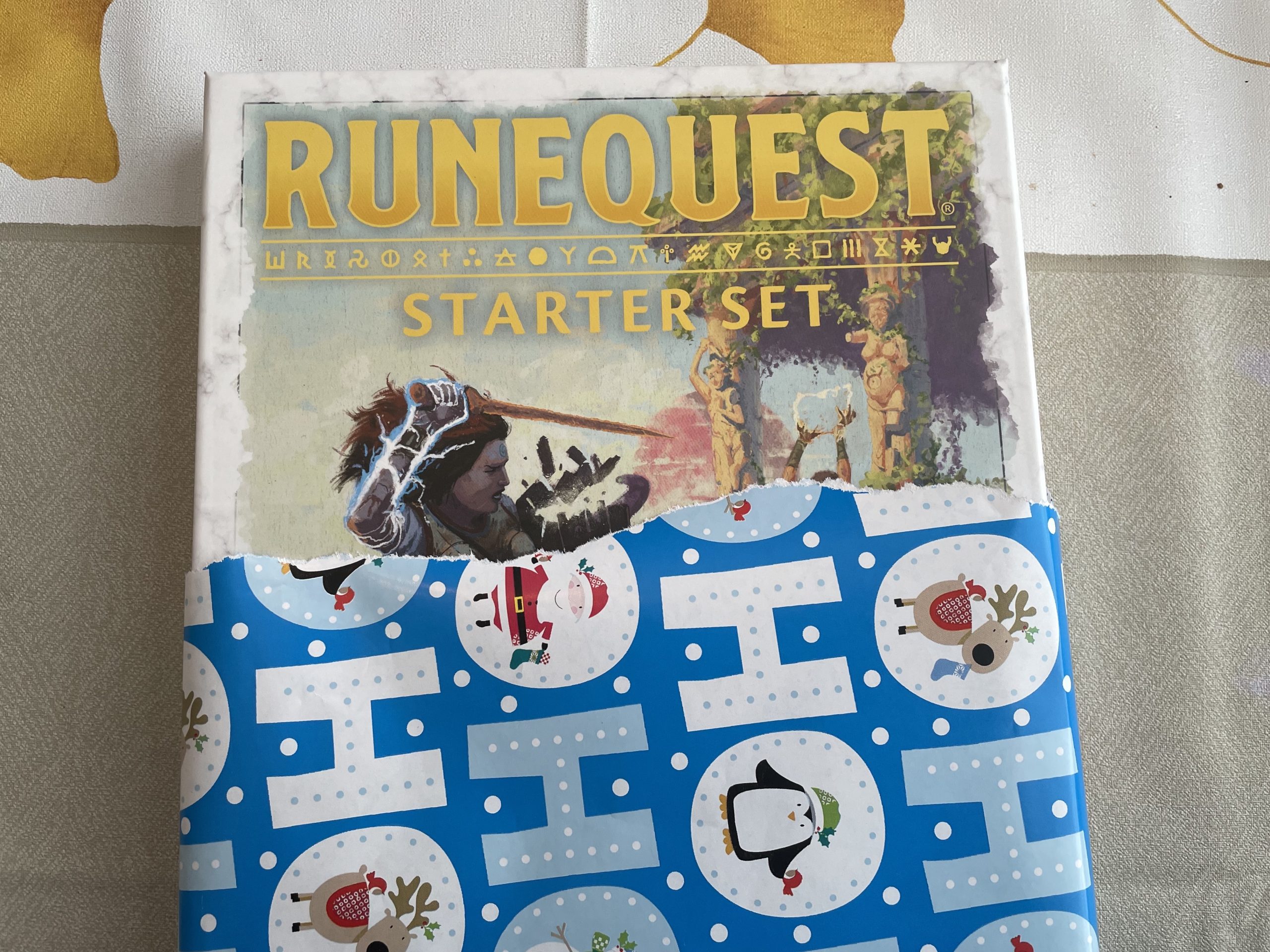
6 comments on “Review: RuneQuest Starter Set”